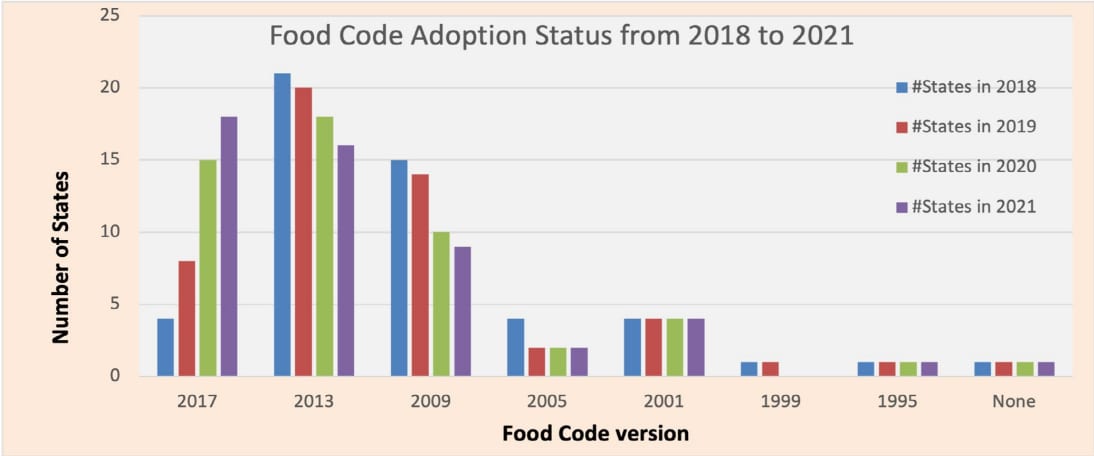
FDA Food Code, Age 30, Up for Adoption (in New Edition)
SCROLL
DOWN
The U.S. Food and Drug Administration (FDA) Food Code, which is based on recommendations from the Conference for Food Protection (CFP), is a model code that represents FDA's best guidance for a uniform system of provisions for retail foodservice operations to help ensure that food is sourced, prepared, stored, presented, and served in a safe manner. It is not federal law. However, it provides scientifically sound food safety advice to more than 3,000 local, state, tribal, and federal food control agencies. California, which has adopted its own code, does not follow the FDA Food Code.
The Food Code is typically updated every four years, with supplements issued between updates, as needed. The last full update was issued in 2017. On December 28, 2022, FDA released the 2022 Food Code (tenth edition) to reflect the input of regulators, industry, academia, and consumers that participated in the 2020 biennial meeting of the CFP. The meeting was held in 2021 due to the pandemic, thus impacting the Food Code publication schedule. The tenth edition of the food code also commemorates 30 years of the Food Code in its current format. We will be speaking with FDA on our Food Safety Matters podcast about the new edition of the Food Code and its use over the past 30 years—so stay tuned for that upcoming episode!
Notable changes in the 2022 Food Code include the addition of sesame as the ninth major allergen to reflect the Food Allergy Safety, Treatment, Education, and Research Act (FASTER Act) of 2021, as well as the addition of labeling and consumer information for major allergens for unpackaged and self-dispensed food items. The 2022 Food Code also revises the definition of intact meat to include meats that are vacuum tumbled with solutions, making FDA's definition consistent with the U.S. Department of Agriculture's mechanically tenderized beef rule of 2015. It also clarifies time and temperature cooking requirements for these meats. Additionally, the 2022 edition creates new requirements for the allowance of pet dogs in outdoor dining spaces, and addresses safe protocols for food intended to be used as food donations. It also lowers the required water temperature at handwashing sinks from at least 100 °F, or 38 °C, to at least 85 °F, or 29.4 °C, and clarifies the naming conventions for several food types. Finally, restricted-use pesticides are now defined as poisonous or toxic materials in the 2022 Food Code.
FDA's Food Code has been adopted by 49 states (with the exception of California, as previously stated) in some form. As of the end of 2021, 18 states were using the 2017 version, and 16 states were using the 2013 version. Fifteen other states plus the District of Columbia were using Food Code versions from 2009 or older. The bureaucratic structure of agencies responsible for regulatory oversight over retail and foodservice establishments varies in each state, which means that the number of state agencies (typically one to three) that have the ability to adopt the Food Code as policy can vary significantly. This is one reason for the difference in the speed of adoption of Food Code editions among states (Figure 11).

FIGURE 1. Food Code Adoption Status among States, 2018–2021 (Source: FDA1)
It is hoped that the release of the 2022 edition will bring more states on board with the updated version, as it is difficult to maintain consistent food safety standards in retail foodservice operations when so much variance exists in adherence to code across states. The desire to get more states on board with the updated version of the Food Code may be one reason that FDA is increasing its focus on retail food safety.
At our 2023 Food Safety Summit in May, we will also increase our focus on retail foodservice with separate foodservice and retail/e-commerce/convenience store community group discussions on the morning of Wednesday, May 10. On Wednesday afternoon, an education session will examine the regulatory impacts of the 1993 Jack in the Box E. coli outbreak, including the creation of the Food Code and HACCP. The Summit will also devote an entire education session to food safety practices in the real world, with discussion of a survey developed by the Association of Food and Drug Officials (AFDO) and the Retail Food Safety Regulatory Association Collaborative on the afternoon of Thursday, May 11. An additional session on Thursday afternoon will examine sanitary design in retail and restaurant facilities. Also, in line with recent adjustments made in the 2022 Food Code, another Thursday session will examine how to reduce food loss and waste through food donations and other initiatives.
I encourage you to take a look at the 2023 Food Safety Summit agenda and pick out your "must attend" sessions (and register) today!
Regards,
Adrienne Blume, Editorial Director

References
- U.S. Food and Drug Administration. "Adoption of the FDA Food Code by State and Territorial Agencies Responsible for the Oversight of Restaurants and/or Retail Food Stores." 2021. https://www.fda.gov/media/107543/download.
